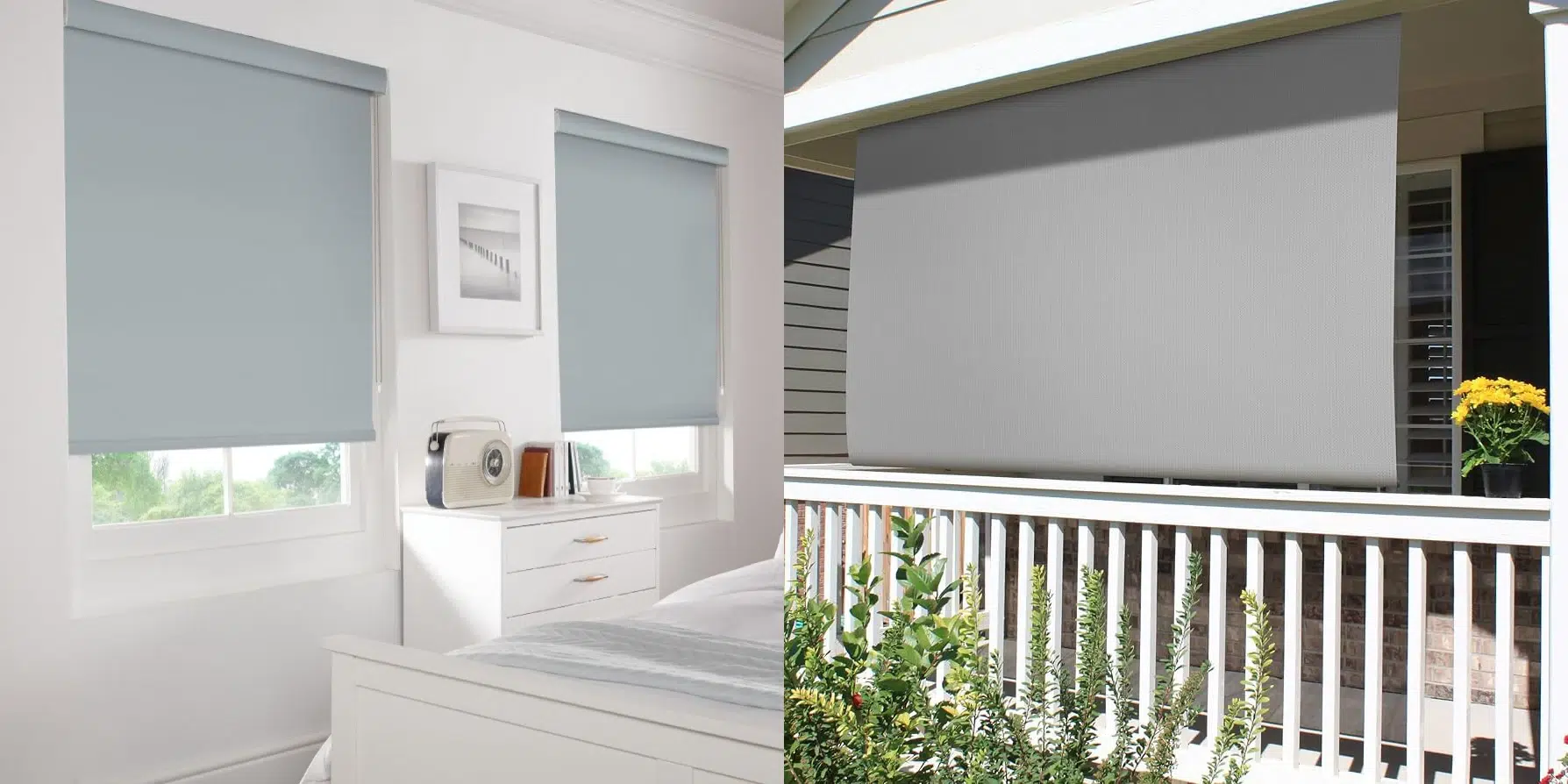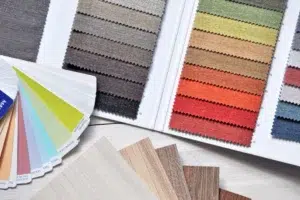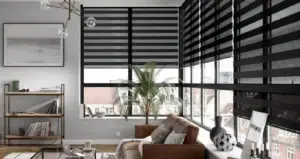Blinds are a versatile and popular choice for window coverings, suitable for indoor and outdoor spaces. However, while they may serve similar purposes, there are distinct differences between blinds designed for indoor use and those intended for outdoor applications. Understanding these key distinctions is essential in selecting the right type of blinds to meet your specific needs, whether you want to enhance your home’s interior or protect your outdoor spaces.
Material and Construction: Tailoring to Different Environments
Indoor Blinds: When it comes to indoor blinds, the materials used are selected with a focus on aesthetics, comfort, and ease of maintenance. Common materials include fabric, wood, vinyl, and aluminum. Fabric blinds, for instance, can add a soft, warm touch to a room, with a wide variety of colors and patterns available to match any decor. Wood blinds bring a natural, elegant feel, often chosen for their classic appearance and timeless appeal. Vinyl and aluminum blinds are popular for their durability and low maintenance requirements, making them ideal for busy households or spaces where ease of cleaning is a priority. These materials are designed to withstand the conditions found indoors, where exposure to moisture, sunlight, and temperature fluctuations is limited.
Outdoor Blinds: Outdoor blinds, on the other hand, are engineered to endure the harsher conditions of the outdoors. The materials used in their construction—such as aluminum, vinyl, and fiberglass—are selected for their strength, durability, and resistance to weather elements like rain, wind, and intense sunlight. These blinds are designed to provide long-lasting protection and functionality, even in environments where they may be exposed to extreme temperatures, humidity, or UV rays. For instance, aluminum blinds are highly resistant to corrosion, making them ideal for areas with high humidity or near the coast. Vinyl and fiberglass blinds are also popular choices due to their ability to resist warping, cracking, or fading over time. This robust construction ensures that outdoor blinds remain effective and visually appealing, even after years of exposure to the elements.
Functionality: Meeting Different Needs
Light Control: Both indoor and outdoor blinds are designed to provide light control, but the way they achieve this can vary significantly. Indoor blinds are primarily focused on controlling the amount of light that enters a room, helping to create a comfortable and private indoor environment. They allow you to adjust the level of natural light according to your preference, whether you want to let in soft, diffused sunlight or block out harsh glare entirely. Indoor blinds are also effective in maintaining privacy, preventing outside views into your home while still allowing you to enjoy the outside scenery if desired.
Outdoor Blinds: Outdoor blinds, while also offering light control, are designed with additional functionality in mind. These blinds are built to withstand the rigors of outdoor conditions, providing not just shade but also protection from the elements. They can be used to create shaded outdoor living areas, such as patios, balconies, or verandas, allowing you to enjoy the outdoors even on hot, sunny days or during light rain. By reducing the amount of direct sunlight that reaches your windows, outdoor blinds can also help lower indoor temperatures, making your home more energy-efficient and comfortable during the warmer months. Some outdoor blinds are designed with adjustable slats or louvers, allowing you to control the angle of sunlight and ventilation, enhancing both comfort and energy efficiency.
Installation and Maintenance: Understanding the Requirements
Indoor Blinds: Installing indoor blinds is generally a straightforward process that many homeowners can handle on their own. These blinds are specifically designed for indoor use, meaning they do not need to be built to withstand harsh environmental conditions. As a result, the installation process tends to be simpler, often requiring just basic tools and a bit of DIY knowledge. Once installed, indoor blinds are relatively low-maintenance. A simple routine of regular dusting or occasional spot cleaning is usually enough to keep them looking fresh and functioning well. Since they are protected from the elements, there is no need to worry about weatherproofing or ensuring additional structural support, making indoor blinds a convenient and easy-to-manage option for your home.
Outdoor Blinds: On the other hand, outdoor blinds are built to endure the challenging conditions of the outdoors. Because they need to be strong enough to resist rain, wind, sunlight, and temperature fluctuations, their installation is typically more complex. Often, outdoor blinds require professional installation to ensure they are securely fitted and capable of withstanding the elements over time. This complexity is not just due to the blinds themselves but also because of the additional support structures that may be necessary to anchor them effectively. Moreover, outdoor blinds generally require more frequent maintenance compared to their indoor counterparts. Regular cleaning is essential to remove dirt, debris, and any potential mold buildup caused by exposure to moisture. Additionally, the hardware that supports outdoor blinds may need periodic tightening or adjustments to maintain optimal performance and safety, especially after severe weather events.
Style and Aesthetics: Enhancing Your Space
Indoor Blinds: One of the major appeals of indoor blinds is the vast array of styles, colors, and materials available. Whether your home’s decor is modern, traditional, or somewhere in between, there is likely an indoor blind option that will complement and enhance your interior design. From sleek, minimalist aluminum blinds that fit perfectly in a contemporary space, to rich wooden blinds that add warmth and elegance to a room, the choices are nearly endless. The focus with indoor blinds is often as much on aesthetics as it is on functionality, allowing you to choose a window treatment that not only serves its purpose but also adds a distinctive touch of style to your living spaces.
Outdoor Blinds: While outdoor blinds are primarily designed with durability and weather resistance in mind, this doesn’t mean that style has to be sacrificed. Outdoor blinds have come a long way in terms of design, and today, they are available in a variety of colors, patterns, and styles that can complement the look of your outdoor spaces. Whether you’re aiming for a rustic, natural feel with earthy tones, or a more modern look with sleek, neutral colors, there are options available to suit your aesthetic preferences. However, it’s important to note that the primary focus of outdoor blinds remains their functionality. The materials used are selected for their ability to withstand the elements, so while there are aesthetic choices to be made, these often come second to the blinds’ practical considerations.
Additional Factors to Consider: Privacy, Cost, and Safety
Privacy: Both indoor and outdoor blinds can enhance privacy, but the level of privacy they provide can vary based on the type of blind and how it is installed. Indoor blinds are excellent at controlling light and visibility within your home, offering a range of options from sheer to blackout styles depending on your needs. They can effectively prevent prying eyes from peeking into your living spaces while still allowing you to enjoy natural light. Outdoor blinds, on the other hand, can add an extra layer of privacy by creating shaded, secluded areas on patios, balconies, or other outdoor spaces. By blocking out sunlight, they not only help to keep your outdoor areas cooler but also shield them from outside view, making them perfect for creating private, comfortable outdoor retreats.
Cost: When it comes to cost, outdoor blinds are generally more expensive than indoor blinds. This is largely due to the materials and construction methods required to make them durable enough to withstand the elements. The added complexity of installation and the need for professional help can also contribute to higher overall costs. However, this investment in outdoor blinds often pays off in the long run, as they are designed to last and provide protection for your home’s exterior spaces. Indoor blinds, while typically more affordable, also vary in cost depending on the materials and design chosen. High-end materials like wood or custom fabrics can increase the price, but in general, indoor blinds offer a wide range of budget-friendly options.
Safety: Safety is an important consideration for both indoor and outdoor blinds, but it is particularly crucial for outdoor installations. Because outdoor blinds are exposed to the elements, they need to be securely installed to prevent accidents. Strong winds, heavy rains, or even the weight of snow can put stress on outdoor blinds, so ensuring they are properly anchored is essential. Regular inspections and maintenance are necessary to check for any signs of wear or damage that could compromise their safety. For indoor blinds, safety considerations often focus on ensuring cords are properly managed to avoid accidents, especially in homes with children or pets.
Wrapping It Up: Making the Right Choice
When it comes to deciding between indoor and outdoor blinds, it’s important to think about what you need for your space. Indoor blinds are great for adding style and functionality to your home’s interior, offering a variety of designs that can enhance any room. On the other hand, outdoor blinds are specifically built to handle the tough weather outside, providing much-needed shade and protection. By understanding the key differences—like the materials used, their specific functions, the ease of installation, and the maintenance they require—you can make a well-informed choice that fits your lifestyle and home perfectly.
Frequently Asked Questions (FAQs)
Q: Can I Use Indoor Blinds Outdoors?
A: It’s generally not advisable to use indoor blinds outside. Indoor blinds are made with materials that aren’t equipped to handle harsh elements like wind, rain, and intense sunlight. Using them outdoors could lead to quick deterioration, meaning they won’t last long or function as intended.
Q: What Are Some Popular Types of Outdoor Blinds?
A: When it comes to outdoor blinds, a few popular options stand out. Roller shades are a common choice for their simplicity and effectiveness. Awnings are also widely used, offering both shade and a touch of style. Vertical blinds are another option, especially good for larger areas like patios or balconies, as they can easily be adjusted to control sunlight and privacy.
Q: How Often Should I Clean My Blinds?
A: The cleaning schedule for your blinds will depend on their type and where they are installed. Indoor blinds usually only need a good cleaning every few months to keep them free of dust and looking fresh. However, outdoor blinds may require more frequent attention because they are exposed to dirt, dust, and other elements from the outdoors. Regular cleaning ensures they stay in good condition and function properly.
Q: Can I Install Blinds Myself?
A: While installing blinds yourself is possible, especially if you’re handy with DIY projects, it’s not always the best route for every type of blind. Simpler indoor blinds might be a fun weekend project, but for more complex or larger-scale installations—particularly outdoor blinds—professional help is often the better choice. A professional installer can ensure that the blinds are securely fitted and function as they should, which is especially important for outdoor setups where the blinds need to withstand the elements.
Q: What Is the Difference Between Solar Shades and Blackout Blinds?
A: Solar shades and blackout blinds serve different purposes. Solar shades are designed to filter sunlight, reducing glare and heat while still allowing some natural light to pass through. They’re great for keeping a room cool without making it completely dark. On the other hand, blackout blinds are all about blocking out light entirely. They’re perfect for bedrooms or media rooms where you want to eliminate outside light for better sleep or viewing conditions.





